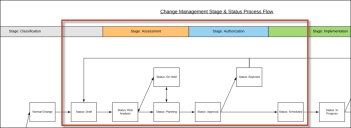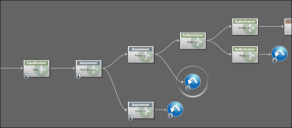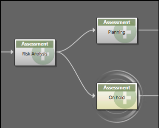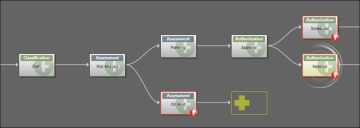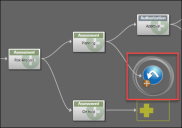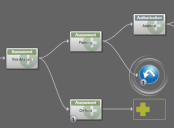Example: Create a Lifecycle
Here is an example to show you how to create part of a big lifecycle using the Business Object Lifecycle Editor.
Use branches to add divergent routes to your lifecycle. Jumps allow you to go backwards through your lifecycle (example: if something is rejected or to reopen a Closed ticket), to visit a status more than once, and to close off a lifecycle.
To replicate this section of this lifecycle you need to use the following statuses, stages, branches, jumps and transitions:
- Open the Lifecycle Editor.
- Drag a status on to the board to form an initial stage (not shown) and then drag another onto the board to the right of that one.
- With the second stage still selected, go to the Properties area. Change the Status Name to Draft and the Stage Name to Classification. Select Tab or Enter or click away to see the name changes reflected on the designer board.
- Drag another status on to the board to the right of Draft. Change the Status Name to Risk Analysis and the Stage Name to Assessment.
Select the New Stage button to name stages.
- Now you need to add a branch to replicate the section shown in the image for the statuses Planning and On Hold. Drag a status and add it to the right of Risk Analysis. Then drag and drop another on top of Risk Analysis.
You see a branch as per step 6 but with default status names. - Change the Status Names to Planning and On hold. You don't need to change the stage name because it was inherited from the previous stage.
Your branch should now look like this: - Now, add the statuses for Approval, Scheduled and Rejected using the same methods. These three statuses are all part of stage Authorization.
Your lifecycle should now look like this: - To clear the red warnings, you need to add a stage and mark it as final. Drag a status to the right of Scheduled, select it and then select Set Final Stage in the Properties area.
Two of the red warnings disappear. If you hover over On Hold, you see a tool tip saying Status has no route to final stage: On Hold. That warning can be fixed in a minute by adding our jumps. - In the original image of the lifecycle you can see double-headed arrows and also a route from Rejected all the way back to Draft. You need to recreate these in the Lifecycle Editor using jumps, so the first jump will be between Planning and On Hold. Drag a jump onto the board and drop it on to Planning.
You see this on your screen: - Then drag the brown cross onto your destination status, in this case, On Hold.
There is now a jump or two-way arrow between the statuses Planning and On Hold. You can tell which statuses are joined by a jump by looking for the matching pairs of jump numbers. - Add the final two jumps: from Rejected to Draft, and from On Hold to Risk Analysis.
When you are finished, your lifecycle should look like the one shown at the top of this page. Take a moment to reflect on the visual differences and similarities between the two images, in particular how jumps represent arrows. - Lastly you need to name the transitions. Think about statuses being adjectives that describe the current state of a record (example: Closed, In Progress, Awaiting Approval) and transitions as verbs that act on the record resulting in the state being changed (example: Close, Begin Work, Approve). For our example lifecycle above, suggested transition names could be as follows:
Selected Status Transition Name (shown on Control) To Status Draft Submit ticket Risk Analysis Risk Analysis Pass risk check Planning Fail risk check On Hold Planning Submit plans for approval Approval Put on hold On Hold Approval Pass approval checks Scheduled Fail approval checks Rejected On Hold Give go ahead Risk Analysis - Select Save on the toolbar (or select Ctrl+S) to save your lifecycle while working. Select OK at the end when editing is complete and you want to save your lifecycle and close the Lifecycle Editor.
- Publish the Blueprint (File > Publish Blueprint) to commit the changes, or save the Blueprint (File > Save Blueprint) to continue making other changes.
If not valid, you are not allowed to save and are asked to fix the issues. See Validate a Lifecycle.
